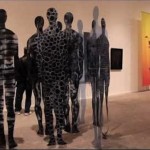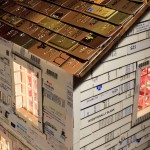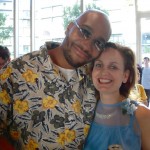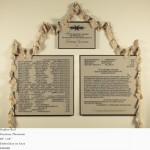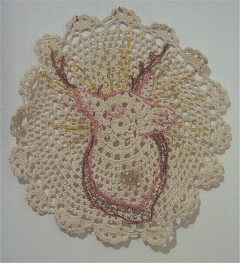
Deer Head Doily by Shannon Robinson, doily and machine stitching, 2005
This year digital processes have taken over in the world of fiber and in quilts, but it almost seems irrelevant to me, except that warps and woofs talk especially loudly to the weavers and quilters and beaders who think in pixilated grids.
For the most part, the digi stuff is just a tool and a process. (Of course fiber folks are process crazy, just like print folks, and some of these artists are both.)
What’s relevant are the beauty and variety, and the input into the Contemporary Art conversation.

left to right, Lisa Whitley from Linden, NJ; Barbara Askew from Detroit; Bettye Blackston from Linden; Venetta Harbin from Jersey City and Gloria Saundra Blackston (Bettye’s sister-in-law) from Yeadon, PA, posing in front of their favorite quilt, Kauri 7, by Kathyanne White. All but one (I think) are quilters.
So if you’ve snored your way through this month’s fiber shows (see previous post), it’s your last chance to wake up and look around. The out-of-town fiber lovers who I met in the galleries, are beating you to it.
This year’s fiber exhibits, which are at a number of venues (see previous post), confirm that the selvages have unraveled and anything goes. Okay, so it’s not news, but it sure is fun to look at.
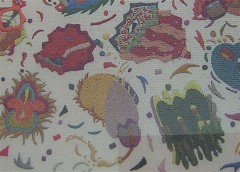
Number Five, by Pat dipaula Klein, hand-stitched cotton floss on linen, 2005
At DaVinci (I’m starting here because it’s all local artists), some witty contemporary work from Shannon Robinson and Pat dipaula Klein stood out. Klein sticks close to traditional technique and materials to make imagery that suggests the fecundity of the natural world via beautiful, cartoon imagery. Robinson goes outside the box with her compressed brick of unraveled baby-blanket wool and her Deer Head Doily, embroidered with machine stitching.
I’m not sure why deer are on every young person’s agenda, but they seem to have become the national symbol for nature under attack, innocence, and purity. I keep seeing deer heads–in glass, in paint, in graphite, cast in resin. It’s not like this was the first generation to survive Bambi. Robinson’s deer head, on a doily, strikes me as a stand-in for a teenage girl’s horse as well as a wild beast in the parlor. It has a saint’s halo behind, making it look a lot like a hunting trophy on a board.
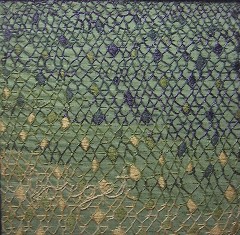
Water Under the Bridge by Marie H. Elcin, embroidery on cotton, 2005
Marie H. Elcin’s If Only I Could See Under the Surface, withthe word “forget” stitched into the waves, also felt contemporary in the way tight stiches create a loose network over the surface, and the way language is incorporated.
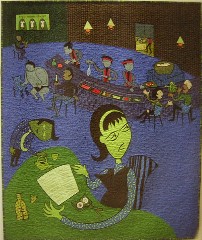
Pam RuBert’s Whine and Dine at Sushi Zen
Cartoon and wit also turned up at the Philadelphia Art Alliance where the official theme was communication. Fortunately, artists will be artists and not comply. I loved witty Whine and Dine at Sushi Zen from Pam RuBert of Springfield, Mo. The stitching and material choices are meticulous and beautiful. The piece communicated just fine with its slice of contemporary life cartoon that would look swell on a New Yorker cover.
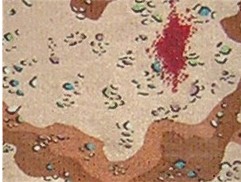
detail from Friendly Fire from Jon Eric Riis, 65 x 85 inches
And while I’m discussing what work looked utterly contemporary, I have to add to the list Jon Eric Riis and his tapestry “Friendly Fire,” at Snyderman, made of metallic thread with a blood spot of red Saworvski crystals. The work cuts both ways, being a serious comment on war at the same time that it comments on fashions in politics and on the body.
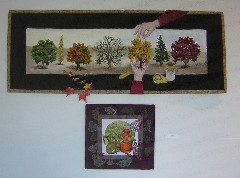
A Seasonal Spectrum (top) and A Quirky Attraction by B.J. Adams, free motion machine embroidery; these get high points for their incredible technique and the texture the layers of machine stitches provide
On another note, the shows had lots of crossover artists, like B.J. Adams, local artist Nancy Herman, Patricia Malarcher at both Klein and Snyderman, and Jette Clover and Jeanne Williamson at both Klein and the Art Alliance. Adams uses meticulous drawing combined with freehand machine embroidery to create images that pop. Herman is using felt.
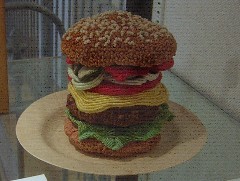
Super Sized by Ed Bing Lee
Ed Bing Lee was at Snyderman as well as at DaVinci. At Snyderman, the ultra-amazing macrame artist of all times offered Pop hamburger and hotdog sculptures, knotted, while at DaVinci he showed a more austere 3-D take on a mineral. Last time we looked at Lee, his hamburgers and hotdogs were Pop 2-D portraits in macrame. I’m thinking watch out, Oldenburg.
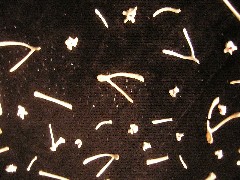
detail of Best Wishes by Amy Orr, at the Painted Bride, bleached chicken bones and beads on velvet; Orr stated that the bones series was an outgrowth of 9/11. What I like is the way the beads and bones look like constellations in the night sky.
Some of the artists in InLiquid’s Exhibit 4 also showed up elsewhere–Amy Orr (Snyderman), and Jacqueline Unanue (DaVinci).
There may have been more crossovers, but those were the ones I caught.

Jeanne Williamson, Orange Construction Fence Series #28, monoprinted, hand painted, hand stamped, machine stitched
What seemed most prevalent was how fiber is being used to explore the same kinds of issues that are elsewhere in the art world. The Minimalist factory-made quality has had some influence, even in fiber, which has a reputation as the last bastion of the crafted and hand-made. There’s some synergy between minimalist grids and the quilt square, which gets some witty treatment in Williamson’s two meditations on orange construction fencing, at the Art Alliance and at Klein, but needle-less to say, grids were woven into every show.
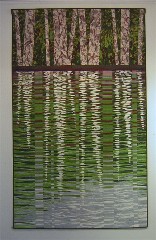
Karen Perrine, Still Water
Continuing the theme of art movements migrating into fiber, we have impressionism, most spectacularly in Karen Perrine’s Still Water quilt at Klein. Also Deborah Anderson’s Fall Rain/Rain Fall picks up some impressionism and pushes it through some Asian, reductive seive to come up with her evocative Fall Rain/Rain Fall.
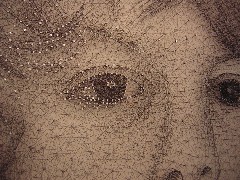
Kim Kamens, Max, thread and nails
Even traditional drawing makes it into fiber art, exemplified by Kim Kamens’ Max. The nail heads rescue what would otherwise be just an exercise in technique. In the same vein were Shisuzko Kimura’s airy croquis in needle and thread.
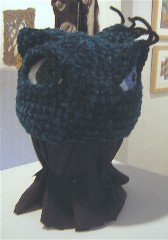
Mary Austin’s Look out! crocheted and beaded, 2006
For the traditional mix of fiber and clothing, standouts were Maris Fisher Krasnegor’s Leafy Jabot (felt) for its color alone and Mary Austin’s fear-factor Look out! hat with eyes all around the head, both at DaVinci.
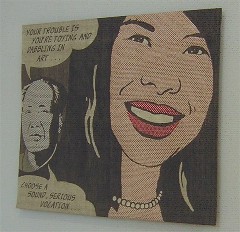
Lisa Lee Peterson’s Pop Art
Narrative also was part of the mix. One that I loved was Lisa Lee Peterson’s Pop Art at Snyderman, an autobiographical piece that shamelessly borrows from Pop and comics in telling its story of a father (a shameless pun on Pop) who warns his daughter against a career in art.
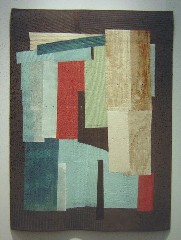
Leesa Zarinelli Gawlik’s Roadside Shed, inspired by Japanese tin sheds and made with overdyed kimono liners
Then there are the color meditations, Leesa Zarinelli Gawlik’s beautiful Roadside Shed at the Art Alliance and Jeanne Butler’s White 10.92 at Klein. Take that, Robert Ryman.
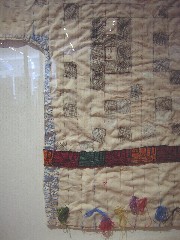
detail of Bhutina Abu-Milhern’s The Needle Vanquished the Sewer 3
For some Middle Eastern flavor, check out Israeli embroidery/sculpture artist Lily Poran, who is inspired by traditional tattoos and Middle Eastern stitchery techniques, and Palestinian Israeli Bhutina Abu-Milhern, whose contemporary stitched, painted and drawn-on shirt looked like a cross between a crossword puzzle and a travel sewing kit.
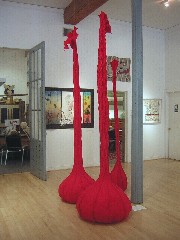
Mi-Kyoung Lee’s untitled flowers as columns
On the sculpture front, I’d have to send you to Snyderman all the way. Mi-Kyoung Lee’s large and small red stretch flowers, Piper Shepard’s filligree of fabric, Lace-Like, Hisako Sekijima’s plant-fiber sculptures and Lewis Knauss’s grass-inspired landscape were standouts. But there was more of interest–so much more that I really didn’t digest it all.
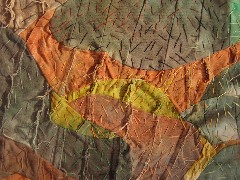
KathyAnne White’s Kauri 7, influenced by tree bark in New Zealand (Art Alliance); it is also the backdrop behind the group of women at the top
It’s pattern and texture that rule in the world of fiber. KathyAnne White’s texture and exuberant shapes were the bar-none favorite of the troupe of women at the Art Alliance. Even when fiber goes digital, which much of it has, with digital photos applied to fabric, digital weaving and knitting, digital embroidery output, etc., pattern and texture distinguish fiber from most painting and much sculpture.
I thought I’d be able to tell you which show I loved the most if you only had time for one. Alas, this I cannot do. It depends on what you’re looking for. I’d go to both quilt shows if quilting were my subject.
I’d go to Snyderman for breadth and depth as well as sculpture.
I’d go to DaVinci to see where the local scene fits (and it does) in the larger fiber picture.
Take your pick. But pick and go.
I’m in the process of putting my fiber photos up at Flickr here, but at the time of this writing, they are not yet all up, nor are they completely labeled.


